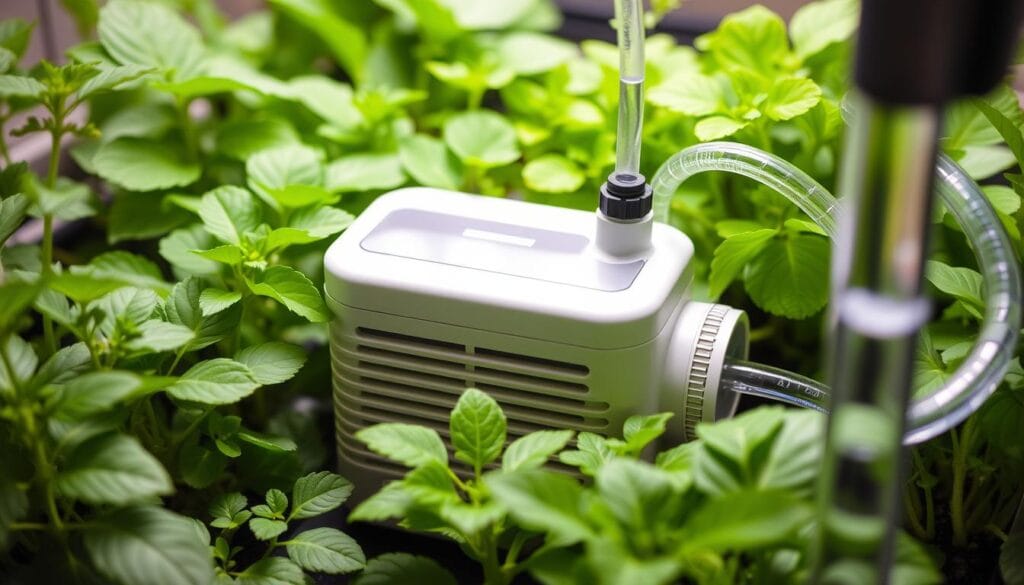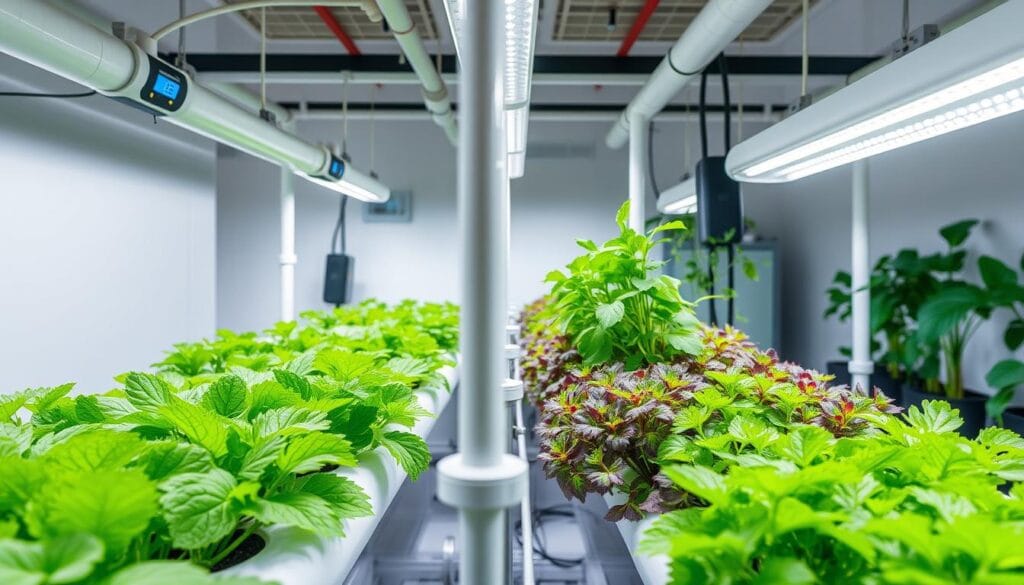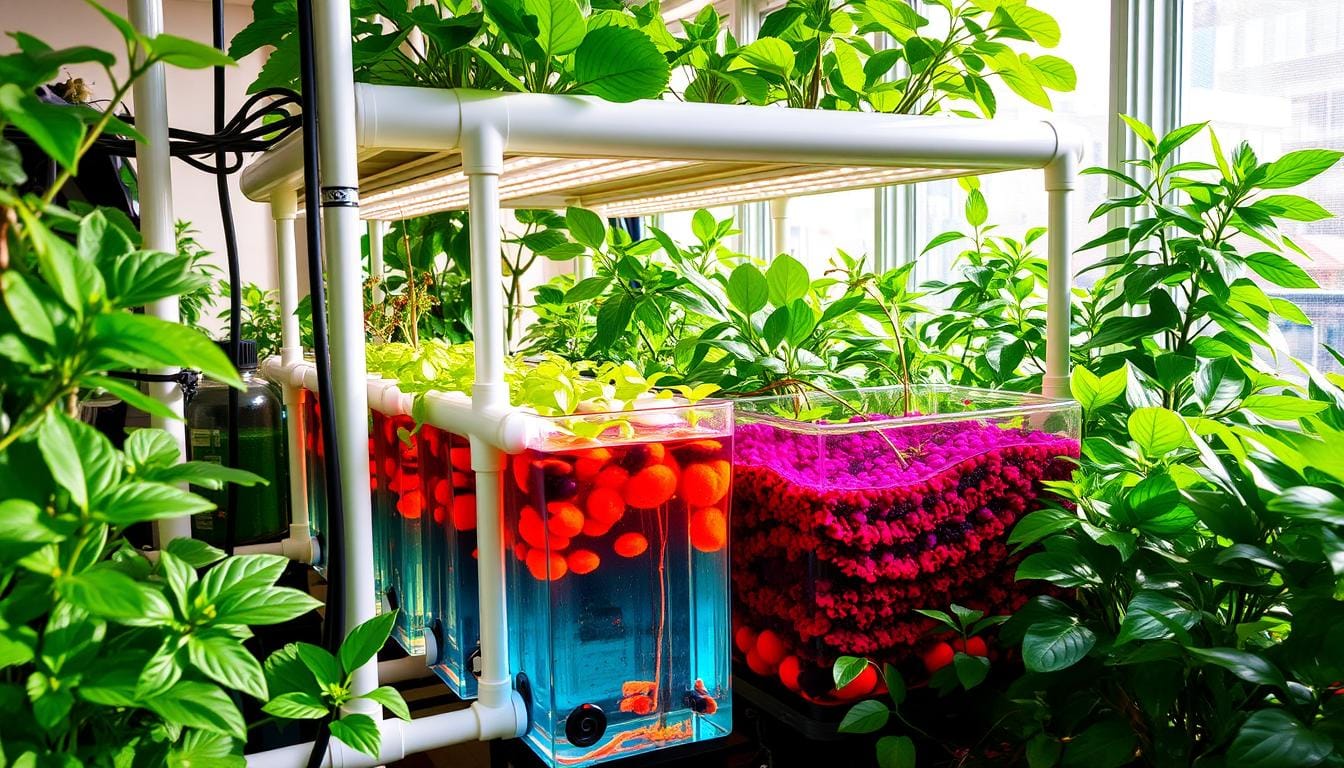Tools and Materials for DIY Hydroponics Setup make growing your herbs and veggies year-round easier. Imagine harvesting fresh tomatoes or lettuce right from home, no matter the season.
Hydroponic gardening changes the game, offering efficient and space-saving solutions. Whether you’re drawn to the Aerogarden, the sleek Click & Grow, or the advanced Gardyn, the options are vast. Each system offers unique features like automatic watering and lighting, perfect for growing many types of plants.
Starting your hydroponic journey means knowing the tools and materials for a thriving garden. From the right grow lights to the best-growing medium, every part is key for your plants to thrive. Let’s explore DIY hydroponics together, unlocking the secrets to a bountiful harvest at home.
Key Takeaways
- Hydroponic systems allow for year-round indoor gardening, with options like Aerogarden, Click & Grow, and Gardyn.
- Choosing the right hydroponic system depends on factors such as plant variety, space efficiency, and ease of maintenance.
- Understanding the key tools and materials, from grow lights to growing media, is essential for successful DIY hydroponics.
- Hydroponic gardening offers benefits like higher yields, reduced water usage, and the ability to grow a wide range of plants.
- Beginners can start with simple hydroponic systems like the wick or water culture method, while more advanced options like the nutrient film technique are also available.
Understanding Basic Hydroponic Systems for Beginners
Hydroponic systems are a new way to garden without soil. They use water full of nutrients to feed plants. This can make plants grow faster and produce more than traditional gardening.
Whether you’re new to gardening or have experience, learning about hydroponic systems is valuable. It assists you in choosing the option that perfectly suits your requirements.
Different Types of Hydroponic Growing Methods
Many different types of hydroponic systems exist, each offering its own benefits. Here are some common ones:
- Wick System: This is a simple and affordable choice. It uses capillary action to move water and nutrients to the roots.
- Deep Water Culture (DWC): Plants float in a solution full of nutrients. This lets their roots absorb what they need directly.
- Ebb and Flow (Flood and Drain): A pump fills the growing tray with solution, and then drains it back into the reservoir.
- Nutrient Film Technique (NFT): Nutrient-rich water flows continuously through channels or tubes to the roots.
- Aeroponics: This method creates a misty environment for roots. It uses less water and nutrients than other systems.
Benefits of Hydroponic Gardening
Hydroponic gardening has many advantages over traditional gardening. Some key benefits are:
- Year-round growing: You can grow plants indoors all year, no matter the weather outside.
- Water efficiency: Hydroponics use up to 90% less water than soil gardening. It’s good for the environment.
- Faster growth rates: Plants in hydroponic systems grow faster and produce more because they get nutrients constantly.
Key Components of a Hydroponic Setup
To set up a hydroponic system, you need a few important things:
- Growing containers: You can use anything from soda bottles to special trays or buckets.
- Nutrient solutions are specialized blends designed to provide plants with the essential nutrients they need for healthy growth.
- Grow lights: Lights like LEDs or fluorescents help plants get the light they need to grow.
- Air pumps: These make sure the nutrient solution is well-oxygenated, which plants need to thrive.
Whether you’re new to gardening or have been doing it for years, hydroponics can be exciting. It lets you grow a wide variety of plants at home. With the right setup and knowledge, you can enjoy the benefits of hydroponic gardening all year round.
Essential Growing Containers and Reservoirs
Choosing the right growing containers and reservoirs is key for a hydroponic system. These parts are crucial for your plants’ health and growth. Let’s look at the different options for these important elements.
Growing containers vary in size and material. You can use seedling containers or specialized hydroponic ones. Small plants like lettuce or herbs need tiny containers. But bigger plants, like tomatoes or peppers, need larger ones.
The reservoir is the core of your hydroponic system. It holds the water and nutrients for your plants. You can make reservoirs from plumbing supplies like plastic buckets or tanks. The reservoir size should match your plants’ needs for water and nutrients.
- Repurposed containers like soda bottles or plastic tubs can be affordable.
- Hydroponic-specific containers, such as net pots or grow cups, offer great support and aeration for roots.
- Reservoirs need to be big enough for your plants’ water and nutrient needs.
- Think about the material and design of your containers and reservoirs. They should fit your hydroponic setup and support your plants well.
By picking the right growing containers and reservoirs, you can make a thriving hydroponic garden. This garden will meet your plants’ needs and help them grow well.
Tools and Materials for DIY Hydroponics: A Complete Checklist
Starting a DIY hydroponics project needs the right tools and materials. You’ll need everything from basic system parts to important measuring tools and safety gear. Having the right equipment is key to growing plants successfully.
Primary Tools for System Assembly
The base of your hydroponic setup is the tools for building it. You’ll need cutting tools like saws and scissors for the containers. Also, drills and connectors like fittings and valves are crucial for putting it all together.
Essential Measuring Instruments
Keeping your plants healthy in a hydroponic system means watching key factors closely. You’ll need pH meters for nutrient absorption, EC meters for nutrient levels, and thermometers for temperature.
Safety Equipment Requirements
Working with water and tools needs safety gear. Use gloves to shield your hands and safety glasses to protect your eyes. Don’t forget timers for setting up your lighting and nutrient schedules.
| Tool/Equipment | Purpose |
|---|---|
| Cutting Tools (Saws, Knives, Scissors) | Shaping growing containers and system components |
| Drills | Creating necessary holes for system assembly |
| Connectors (Fittings, Valves, Tubing) | Assembling the various system components |
| pH Meters | Monitoring and adjusting nutrient solution pH |
| EC Meters | Tracking nutrient concentration in the solution |
| Thermometers | Ensuring optimal temperature for plant growth |
| Gloves | Protecting hands during setup and maintenance |
| Safety Glasses | Shielding eyes from splashes or debris |
| Timers | Automating lighting and nutrient delivery schedules |
With this complete toolkit, you’re ready to build and care for a thriving DIY hydroponic system. You’ll have all the diy hydroponics tools and materials, ph meters, and timers you need.
Selecting the Right Grow Lights and Lighting Systems
Proper lighting is key for any indoor hydroponic garden. You can choose from LED, fluorescent, and High-Intensity Discharge (HID) lights. Each option offers its own set of benefits and considerations.
LED grow lights are popular for hydroponics because they’re energy-efficient and last long. They can be set to give plants the right light for each growth stage. This helps plants grow strong stems and leaves, or boosts blooming and fruiting. Plus, they don’t get hot, so you don’t need big cooling systems.
Fluorescent lights, like T5 and CFL, are good for seedlings and small plants. They’re cool, don’t get hot, and are cheaper than other options. They’re perfect for beginners or hobbyists starting their hydroponic journey.
HID lights, like Metal Halide (MH) and High-Pressure Sodium (HPS) bulbs, are great for certain growth stages. But, they need good ventilation to prevent damage from heat. MH bulbs are cool and blue, good for growing plants. HPS bulbs are warm and red, best for making plants bloom and produce fruit.
| Light Type | Energy Efficiency | Heat Output | Spectrum | Best for |
|---|---|---|---|---|
| LED | High | Low | Customizable | All growth phases |
| Fluorescent | Moderate | Low | Broad | Seedlings and small plants |
| HID (MH) | Moderate | High | Cooler, blueish | Vegetative growth |
| HID (HPS) | Moderate | High | Warmer, reddish | Flowering and fruiting |
When picking grow lights, think about energy use, heat, and light spectrum. This helps ensure your plants thrive and yield abundantly. Adjust light intensity and time based on your plants’ needs and growth stage.
“Adequate lighting is crucial for the success of an indoor hydroponic garden. It forms the foundation for healthy plant growth and optimal garden performance. Choosing the right grow lights can make all the difference in the health and yield of your plants.”
Whether you’re new or experienced in hydroponics, knowing about different grow lights is key. It helps you create the best lighting for your indoor hydroponic system.
Nutrient Solutions and pH Management Tools
Keeping your hydroponic garden healthy means balancing nutrients and pH levels. Hydroponic solutions give plants the nutrients they need for growth. pH testing and adjustment tools help plants absorb these nutrients well.
Essential Nutrients for Plant Growth
Hydroponic solutions provide plants with key nutrients. These nutrients include nitrogen for leaf growth, phosphorus for root development, and potassium for overall plant health. They also have calcium, magnesium, and other micronutrients for various functions.
Recipes like the Modified Sonneveld Solution for herbs give the right nutrient amounts. This ensures plants grow well.
pH Testing and Adjustment Methods
Managing pH is key in hydroponics. Most plants do best in a pH of 5.5 to 6.0. But blueberries like it more acidic, between 4.0 and 5.0.
Digital pH meters are the best for checking pH. pH test strips and liquid kits can also work, but they’re not as accurate.
To change pH, use pH up or down solutions. You can also use white vinegar, baking soda, or citrus juice for small adjustments.
Water Quality Management
Water quality is crucial for your hydroponic garden. If your tap water is bad, use filtered or distilled water. This keeps your nutrient solutions balanced and clean, protecting your plants.
Learning to use nutrient solutions and pH tools well helps your plants grow. They will thrive and give you plenty of harvests.
Air Pumps and Oxygenation Equipment
Keeping your hydroponic plants healthy and growing well depends on oxygen. Air pumps and aeration tools are key to making sure plants get enough oxygen. The size and strength of the air pump you need depends on how big your hydroponic system is and how many plants you have.
The EcoPlus 793 GPH Commercial Air Pump is great for systems over 20 gallons. It helps prevent root rot by keeping roots well-oxygenated. The General Hydroponics Dual Diaphragm Air Pump is an excellent option for systems of all sizes, from small to large. It can move up to 24,800 cc per minute.
For a beginner-friendly setup, the Active Aqua Air Pump is a good pick. It’s quiet but powerful, with a flow rate of 240 GPH. Commercial growers or those with big systems can find the right EcoPlus commercial air pump. They come in sizes from 793 GPH to 3566 GPH.
| Air Pump Model | Flow Rate | Suitable for |
|---|---|---|
| EcoPlus 793 GPH Commercial Air Pump | 793 GPH | Medium to large hydroponic systems (above 20 gallons) |
| General Hydroponics Dual Diaphragm Air Pump | 320 mph or 24,800 cc/min | Small to large hydroponic reservoirs |
| Active Aqua Air Pump | 240 GPH | Beginner hydroponic systems and small-scale setups |
| EcoPlus Commercial Air Pumps | 793 GPH to 3566 GPH | Medium to large hydroponic systems and commercial growers |
Choosing the right air pump is key for your plants’ health. Make sure it’s strong enough to oxygenate well. For both durability and safety, use non-toxic, food-grade tubing. Also, pick a high-quality airstone for better oxygen absorption by the roots.
Running your air pump all the time is best. It keeps plants healthy, extends pump life, and stops algae and pathogens. If the pump’s noise bothers you, wrapping it in a towel or sponge might help. But it could also shorten its life a bit.

By getting the right air pumps and oxygen gear, your hydroponic plants will get the oxygen they need. This helps them grow well and reach their full potential.
Growing Media Options and Their Applications
Choosing the right growing media is key for a healthy hydroponic garden. Options like rockwool and coconut coir affect water retention, aeration, and nutrient absorption. Knowing these differences helps pick the best medium for your plants.
Comparing Different Growing Mediums
Rockwool is a top choice for its water-holding ability and root support. Perlite boosts drainage and aeration, perfect for systems needing more oxygen. Coconut coir balances water retention with root oxygenation, making it sustainable and effective.
Clay pebbles are great for Deep Water Culture (DWC) setups. They help with drainage and support root growth.
Best Practices for Medium Selection
Consider your system type, plant needs, and personal preferences when choosing a medium. Some systems, like Gardyn, use pods with pre-selected media for best results. Reusable media can save money but need cleaning and sterilization to stay effective.
| Growing Medium | Key Features | Ideal Applications |
|---|---|---|
| Rockwool | Excellent water-holding capacity, stable support for roots | Suitable for a wide range of hydroponic crops, including leafy greens, herbs, and strawberries |
| Perlite | Enhances drainage and aeration, promotes healthy root growth | Ideal for systems that require improved oxygen circulation, such as Deep Water Culture (DWC) |
| Coconut Coir | pH-neutral, provides a balance of water and air for root health | Versatile medium suitable for a variety of hydroponic crops, including leafy greens and herbs |
| Clay Pebbles | Helps with drainage and root support, especially in DWC setups | Recommended for Deep Water Culture (DWC) hydroponic systems |
Understanding each medium’s unique properties helps choose the right one for your hydroponic garden. This ensures your plants thrive, leading to a productive garden.
“Selecting the right growing medium is crucial to the success of your hydroponic garden. Each medium offers distinct advantages, and choosing the one that best suits your system and plant requirements can make all the difference.”
Monitoring and Control Systems
Maintaining the right growing conditions is crucial for hydroponic success. Monitoring and control systems help manage key factors such as lighting, nutrients, pH, and the environment, ensuring plants remain healthy and productive.
Timers are vital in hydroponics. They control the light schedule, helping plants grow well. Automated timers also manage nutrient delivery, keeping feeding consistent.
pH and EC meters are crucial for hydroponic gardeners. They monitor the acidity and nutrient levels of the solution. This lets growers adjust for the best plant growth.
For advanced setups, systems like Gardyn offer detailed control. They use sensors, apps, and auto-adjustments to monitor everything. This includes temperature, humidity, nutrients, and water quality.
Regular monitoring and adjustments are vital for maintaining healthy plants. Monitoring key metrics helps growers fix issues fast. This keeps the hydroponic system running smoothly.
| Monitoring Tool | Purpose |
|---|---|
| Timers | Regulate lighting and nutrient delivery schedules |
| pH Meters | Monitor and adjust the acidity of the nutrient solution |
| EC Meters | Measure the electrical conductivity to monitor nutrient concentration |
| Smart Hydroponic Systems | Provide comprehensive monitoring and automated adjustments |
Using various monitoring and control systems ensures plants get the best growing conditions. This leads to healthier plants and increased yields. Investing in these tools is crucial for a successful hydroponic setup.

Conclusion
DIY hydroponics is a great way to grow food all year, even in small spaces. You need the right tools and materials like containers, lights, and nutrients. These help your garden grow well and give you lots of food.
Setting up your hydroponic garden might cost some money at first. But, having fresh food from your garden is worth it. Hydroponics use much less water than regular gardens and can grow more food because of better growing conditions.
Anyone can start a diy hydroponics tools and materials garden with some research and effort. This way, you help your community, save the planet, and enjoy growing your own food. It’s a rewarding and healthy choice.

